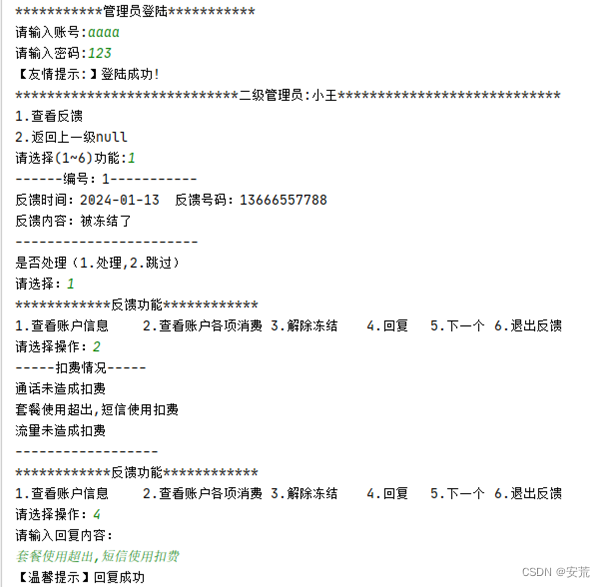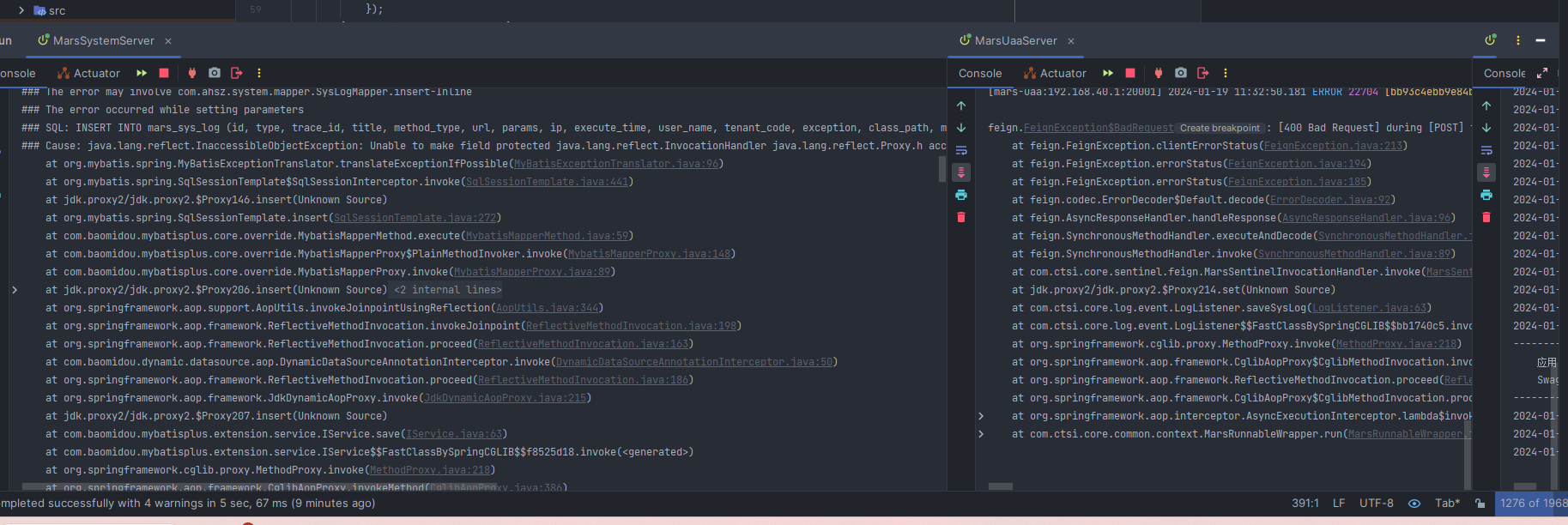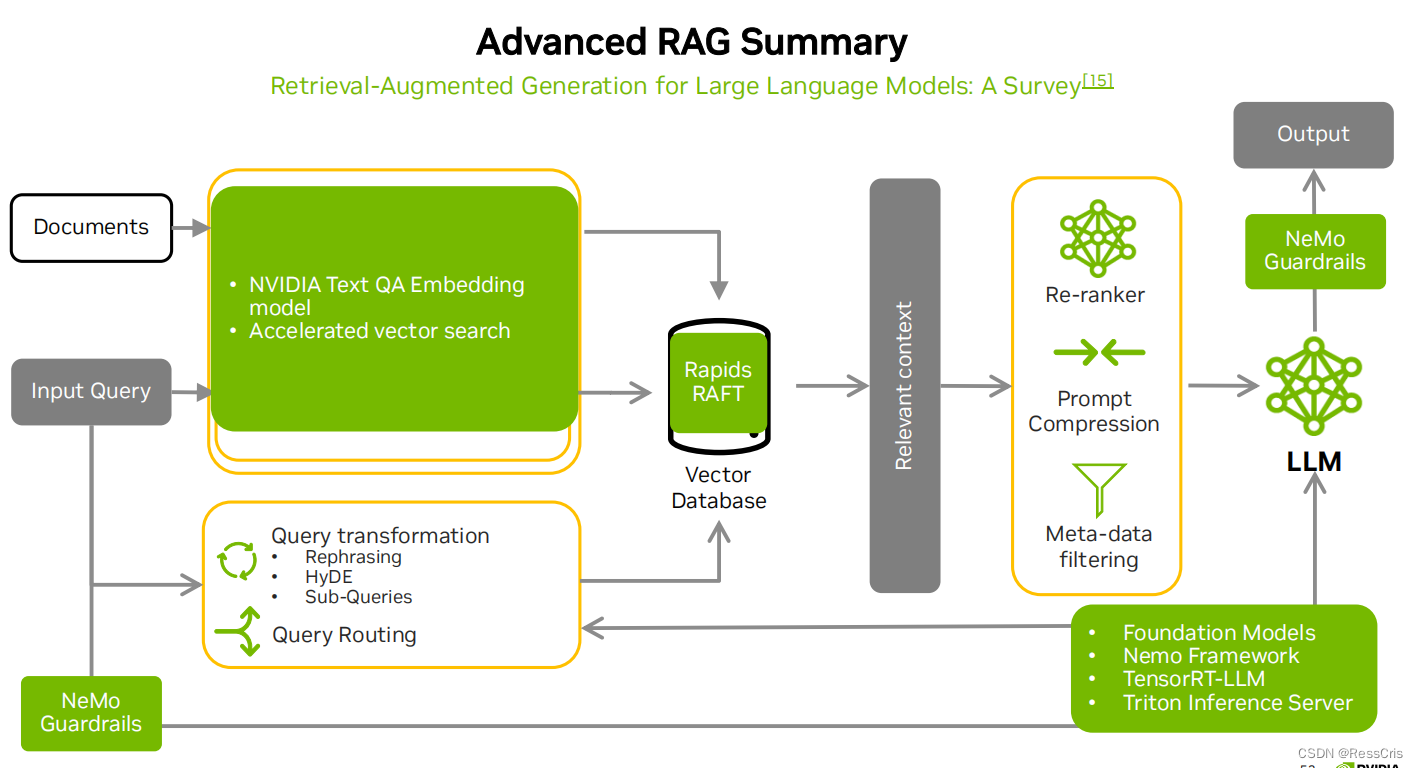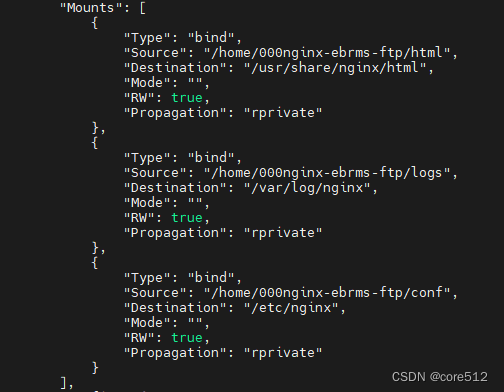简介
typedi是一个基于TS的装饰器和reflect-metadata的依赖注入轻量级框架,使用简单易懂,方便拓展。
使用typedi的前提是安装reflect-metadata,并在项目的入口文件的第一行中声明import ‘reflect-metadata’,这样就会在原生的Reflect API上挂载metadata操作相关的API。
前提
- 项目中引入reflect-metadata依赖
pnpm add reflect-metadata
- 在项目的入口文件的第一行声明
import 'reflect-metadata'
- 在tsconfig.json中开启装饰器语法和装饰器元数据
{"compilerOptions": {"experimentalDecorators": true,"emitDecoratorMetadata": true}
}
当开启了emitDecoratorMetadata后,TS会自动为装饰器生成metadata,有3个metadata:
design:type被装饰器修饰的目标的类型,即成员的类型design:paramtypes方法的参数的类型集合,是一个数组,只有被修饰是方法时,此metadata才有效,否则就是undefineddesign:returntype方法的返回值类型,只有方法独有的metadata
安装typedi
pnpm add typedi
注册实例到容器中
typedi是基于IOC和DI的思想,因此需要有一个容器来容纳所有的bean
有三种方式注册你的实例到容器Container中:
- 使用
@Service()修饰的类(声明式) - 用
Token注册一个实例(手动式) - 用字符串来注册一个实例(手动式)
Token和字符串标识符可以用来注册类以外的其他值。Token和字符串标识符都可以注册任何类型的值,包括除undefined之外的原始值。它们必须在容器上用Container.set()函数设置,然后才能通过Container.get()请求它们。
使用@Service注入:
import 'reflect-metadata'
import { Service, Container } from 'typedi'@Service()
class Person {name: string = 'John'age: number = 30
}const obj = Container.get(Person) as Personconsole.log(obj)
// Person { name: 'John', age: 30 }
使用Token或字符串注入:
import 'reflect-metadata'
import { Service, Container, Token } from 'typedi'Container.set('message', 'Hello World')
console.log(Container.get('message')) // Hello Worldconst token = new Token('TOKEN_INDEX')
Container.set(token, 'Nice to meet you!')
console.log(Container.get(token)) // Nice to meet you!
依赖注入
三种方式注入依赖的实例:
- 通过类的构造函数参数自动注入
- 使用
@Inject()装饰器来标注需要注入的属性 - 直接使用
Container.get()来获取实例,手动注入
构造函数参数注入
import 'reflect-metadata'
import { Service, Container, Token } from 'typedi'@Service()
class A {say(){console.log('A ...')}
}@Service()
class B {constructor(public a: A){}say(){console.log('B ...')this.a.say()}
}const b = Container.get(B) as B
b.say()
// B ...
// A ...
@Inject()属性注入
import 'reflect-metadata'
import { Service, Container, Token, Inject } from 'typedi'@Service()
class A {say(){console.log('A ...')}
}@Service()
class B {@Inject()a: Asay(){console.log('B ...')this.a.say()}
}const b = Container.get(B) as B
b.say()
// B ...
// A ...
bean的作用域
默认注入到容器中的实例都是单例的,即每次从容器中获取的对象都是同一个对象
import 'reflect-metadata'
import { Service, Container, Token, Inject } from 'typedi'@Service()
class Person {name = 'John Doe'age = 21
}const obj1 = Container.get(Person)
const obj2 = Container.get(Person)
// 判断两个对象是否是同一个对象
console.log(obj1 === obj2) // true
如果想要每次请求容器时,都会得到一个新的对象,可以这样做
import 'reflect-metadata'
import { Service, Container, Token, Inject } from 'typedi'@Service({ transient: true })
class Person {name = 'John Doe'age = 21
}const obj1 = Container.get(Person)
const obj2 = Container.get(Person)
// 判断两个对象是否是同一个对象
console.log(obj1 === obj2) // false
@Inject
@Inject是一个属性和参数装饰器,用于解决一个类的属性或构造函数参数的依赖
默认情况下,他能推断出属性或参数的类型,并初始化一个检测到的类型的实例,然而这种行为可以通过指定一个自定义的可构造类型、Token或已命名的Service作为第一个参数 来覆盖
属性注入
属性的类型是自动推断出来的,所以不需要定义所需的值来作为装饰器的参数
import 'reflect-metadata';
import { Container, Inject, Service } from 'typedi';@Service()
class InjectedExampleClass {print() {console.log('I am alive!');}
}@Service()
class ExampleClass {@Inject()withDecorator: InjectedExampleClass;withoutDecorator: InjectedExampleClass;
}const instance = Container.get(ExampleClass);/*** `instance`变量是一个ExampleClass实例* 其`withDecorator`属性包含一个InjectedExampleClass实例* 而`withoutDecorator`属性undefined*/
console.log(instance);instance.withDecorator.print();
// "I am alive!" (InjectedExampleClass.print 方法)
console.log(instance.withoutDecorator);
// undefined, 因为这个属性没有用@Inject装饰器标记
构造函数注入
构造函数注入,当一个类被@Service装饰器标注时,在构造器注入中不需要@Inject装饰器,TS会自动推断并为每个构造参数注入正确的类实例。
但是注意,@Inject可以用来覆盖注入的类型
import 'reflect-metadata';
import { Container, Inject, Service } from 'typedi';@Service()
class InjectedExampleClass {print() {console.log('I am alive!');}
}@Service()
class ExampleClass {constructor(@Inject()public withDecorator: InjectedExampleClass,public withoutDecorator: InjectedExampleClass) {}
}const instance = Container.get(ExampleClass);/*** `instance'变量是一个ExampleClass实例* 它同时具有
`withDecorator`和`withoutDecorator`属性* 都包含一个
InjectedExampleClass实例。*/
console.log(instance);instance.withDecorator.print();
// 输出 "I am alive!" (InjectedExampleClass.print function)
instance.withoutDecorator.print();
// 输出 "I am alive!" (InjectedExampleClass.print function)
明确请求目标类型
默认情况下,TypeDI将尝试推断属性和参数的类型并注入适当的类实例。当必要时,可以覆盖注入值的类型:
- 通过
@Inject( () => type),其中type是一个可构造的值(例如,一个类的定义) - 通过
@Inject(myToken),其中myToken是一个Token类的实例 - 通过
@Inject(serviceName),其中serviceName是一个字符串,已经通过Container.set(serviceName, value)注册过了
import 'reflect-metadata';
import { Container, Inject, Service } from 'typedi';@Service()
class InjectedExampleClass {print() {console.log('I am alive!');}
}@Service()
class BetterInjectedClass {print() {console.log('I am a different class!');}
}@Service()
class ExampleClass {@Inject()inferredPropertyInjection: InjectedExampleClass;/*** 我们告诉TypeDI,用`BetterInjectedClass`类初始化。* 不管推断的类型是什么。*/@Inject(() => BetterInjectedClass)explicitPropertyInjection: InjectedExampleClass;constructor(public inferredArgumentInjection: InjectedExampleClass,/*** 我们告诉TypeDI,用`BetterInjectedClass`类初始化。* 不管推断的类型是什么。*/@Inject(() => BetterInjectedClass)public explicitArgumentInjection: InjectedExampleClass) {}
}/*** `instance`变量是一个 ExampleClass 的实例,同时具有* - `inferredPropertyInjection` 和 `inferredArgumentInjection` 属性* 都包含一个`InjectedExampleClass`实例* - `explicitPropertyInjection`和`explicitArgumentInjection`属性* 都包含一个`BetterInjectedClass'实例。*/
const instance = Container.get(ExampleClass);instance.inferredPropertyInjection.print();
// "I am alive!" (InjectedExampleClass.print function)
instance.explicitPropertyInjection.print();
// "I am a different class!" (BetterInjectedClass.print function)
instance.inferredArgumentInjection.print();
// "I am alive!" (InjectedExampleClass.print function)
instance.explicitArgumentInjection.print();
// "I am a different class!" (BetterInjectedClass.print function)
循环依赖
依赖注入最常见的问题就是循环依赖,因此为了避免循环依赖,我们需要为属性指明类型
在循环依赖的情况下,TS无法推断出属性的类型,就导致design:type为undefined,typedi就无法实例化,因此我们需要强制给出类型。
// Car.ts
@Service()
export class Car {@Inject(type => Engine)engine: Engine;
}// Engine.ts
@Service()
export class Engine {@Inject(type => Car)car: Car;
}
注意这种方式只能解决属性注入,不能解决构造参数的注入。
需要注意的是,通常循环依赖意味着:
- 模块间的指责分工不明
- 单个模块的指责过多(不满足单一职责原则)
- 缺少合理的抽象层
Service Token
在使用@Service()来注入一个实例到Container中时,我们可以给出@Service()参数,用来唯一标识这个实例,参数类型通常是字符串或Token类型。
使用字符串
import 'reflect-metadata'
import { Service, Token, Container, Inject } from 'typedi'@Service('userComponet')
class Person {name = 'john'
}@Service('userIndex')
class PersonController {@Inject('userComponet')obj: Personsay(){console.log('userIndex ... ',this.obj.name)}
}console.log((Container.get('userComponet') as Person).name); // john(Container.get('userIndex') as PersonController).say() // userIndex ... john
使用Token
Service Token 可以用来标识Container中唯一的一个实例,可以安全地从Container中获取Bean
import 'reflect-metadata';
import { Container, Token } from 'typedi';export const JWT_SECRET_TOKEN = new Token<string>('MY_SECRET');Container.set(JWT_SECRET_TOKEN, 'wow-such-secure-much-encryption');/*** 这个值是类型安全的,因为Token是类型化的。*/
const JWT_SECRET = Container.get(JWT_SECRET_TOKEN);
console.log(JWT_SECRET)
可以与@Inject()搭配使用,覆盖属性或参数的推断类型
import 'reflect-metadata';
import { Container, Token, Inject, Service } from 'typedi';export const JWT_SECRET_TOKEN = new Token<string>('MY_SECRET');Container.set(JWT_SECRET_TOKEN, 'wow-such-secure-much-encryption');@Service()
class Example {@Inject(JWT_SECRET_TOKEN)myProp: string;
}const instance = Container.get(Example);
// instance.myProp属性有为Token分配的值。
同名的Token
两个具有相同名称的Token是不同的Token,一个Token实例是唯一的,类似于Symbol类型。
import 'reflect-metadata';
import { Container, Token } from 'typedi';const tokenA = new Token('TOKEN');
const tokenB = new Token('TOKEN');Container.set(tokenA, 'value-A');
Container.set(tokenB, 'value-B');const tokenValueA = Container.get(tokenA);
// tokenValueA 是 "value-A"
const tokenValueB = Container.get(tokenB);
// tokenValueB 是 "value-B"console.log(tokenValueA === tokenValueB);
// false
Token和字符串的对比
Token和字符串都可以用来标识一个Service实例,但是推荐使用Token,因为Token是类型安全的,而同一个string的名称真的就是唯一表示Service实例。
继承性
当基类和继承类都被标记为@Service()后,属性是支持继承性的。
在创建时,继承有装饰属性的类将收到这些属性上的初始化实例。
即当子类继承了父类的依赖注入的属性时,子类中的此属性也是可以直接使用的
import 'reflect-metadata';
import { Container, Token, Inject, Service } from 'typedi';@Service()
class InjectedClass {name: string = 'InjectedClass';
}@Service()
class BaseClass {name: string = 'BaseClass';@Inject()injectedClass: InjectedClass;
}@Service()
class ExtendedClass extends BaseClass {name: string = 'ExtendedClass';
}const instance = Container.get(ExtendedClass);console.log(instance.injectedClass.name);
// 输出"InjectedClass"
console.log(instance.name);
// 输出 "ExtendedClass"
参考文章
https://static.kancloud.cn/czkme/dependency-inject/2511047
源码解读
原理说明
依赖注入的核心就是容器Container
Container.set(id, value)向容器中push一个实例
Container.get(id)从容器中get一个实例
Container容器对象中的核心概念:
- ServiceMetadata,被容器接管的每个类都叫做一个Service,ServiceMetadata就是这个类对应的信息,每个类都有一个与之对应的ServiceMetadata实例
- metadataMap,是一个map,保存的是某一个类的配置信息
- handlers,是一个数组,所有
@Inject()的属性都是一个handler,表示待注入的属性。此容器接管的所有类中的@Inject()标注的属性都在这个数组中
按照装饰器的执行顺序,一个类中的@Inject()先执行,然后是@Service()
@Inject可以用在属性和构造参数上。
看一下ServiceMetadata的结构
export interface ServiceMetadata<Type = unknown> {// service的唯一标识,id: string | Token | Constructable | AbstractConstructor | CallableFunction; /*** 实例的作用域* singleton 单例模式, 单例的实例会被放在default容器中* container 从指定容器中创建实例,从此容器中也是单例的* transient 瞬时的,每次从容器请求都会创建一个新的实例*/scope: 'singleton' | 'container' | 'transient'; // Service的类型,就是构造函数类型type: Constructable<Type> | null; // 创建此类型实例的工厂,factory: [Constructable<unknown>, string] | CallableFunction | undefined; // 此实例的工厂方法// 目标类的实例value: unknown | Symbol;// 是否允许在同一个service id下注册多个实例multiple: boolean;/*** 是否立即实例化,当为true,容器创建完成后就会实例化此类的bean;* 当为false,只有当用时才会实例化*/eager: boolean;/*** 引用此类的 metadata 的容器*/referencedBy: Map<ContainerIdentifier, ContainerInstance>;
}
@Inject的原理
首先要清楚@Inject()的用法:
- @Inject()中可以给Service的id,用来指定注入特定的实例
- @Inject()中的参数还可以是一个函数,用来强制修改要注入的类型
一个Handler的结构
export interface Handler<T = unknown> {// 属性所在的类(构造函数),即此属性需要注入的目标类object: Constructable<T>; // 成员名称propertyName?: string;// 成员在构造函数参数中的索引,// 若@Inject()标注的是类中实例属性,则此属性为undefinedindex?: number;// 一个方法,在@Inject()中已经实现了,从指定的容器中获取此属性的实例value: (container: ContainerInstance) => any;
}
当在一个属性上标注了@Inject()后,实际上就发生了一件事情,向容器中注入一个此属性的handler
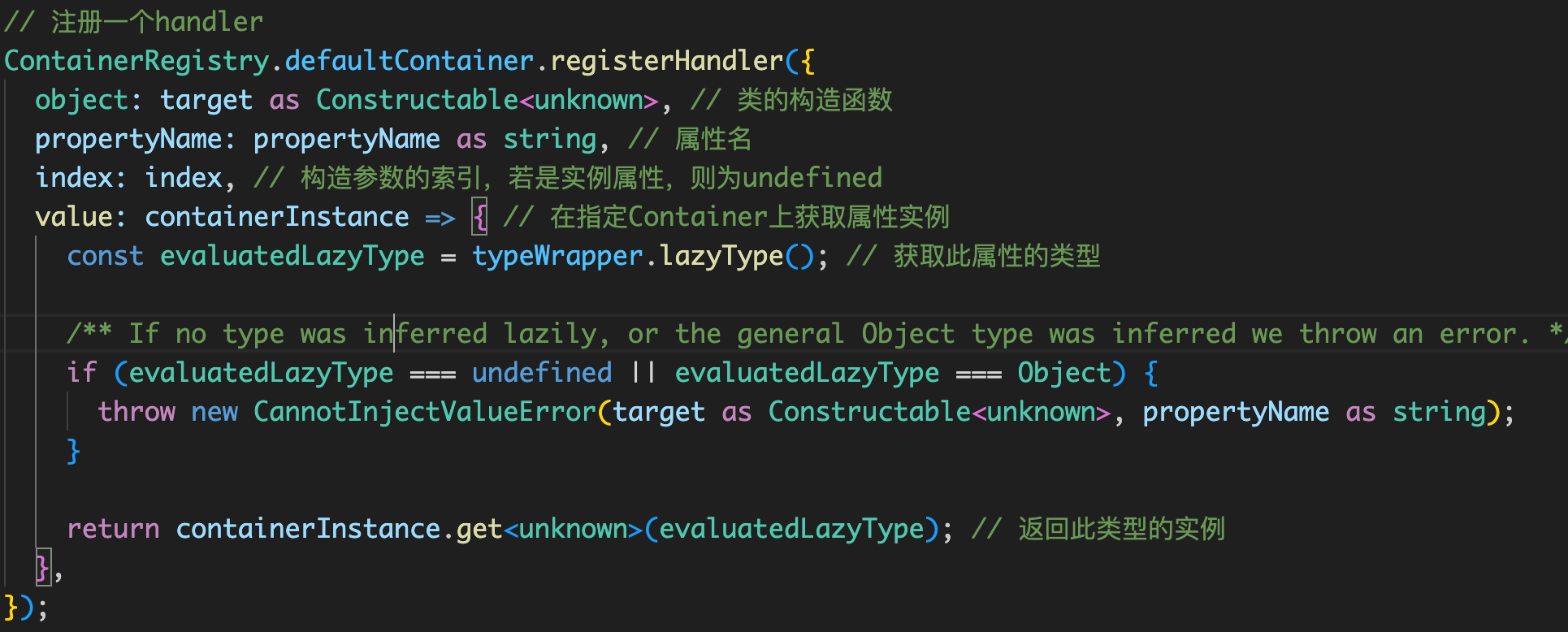
@Service发生了什么
@Service()发生了两件事:
- 初始化此class的ServiceMetadata
- 向Container.metadataMap()中push这个ServiceMetadata
看图
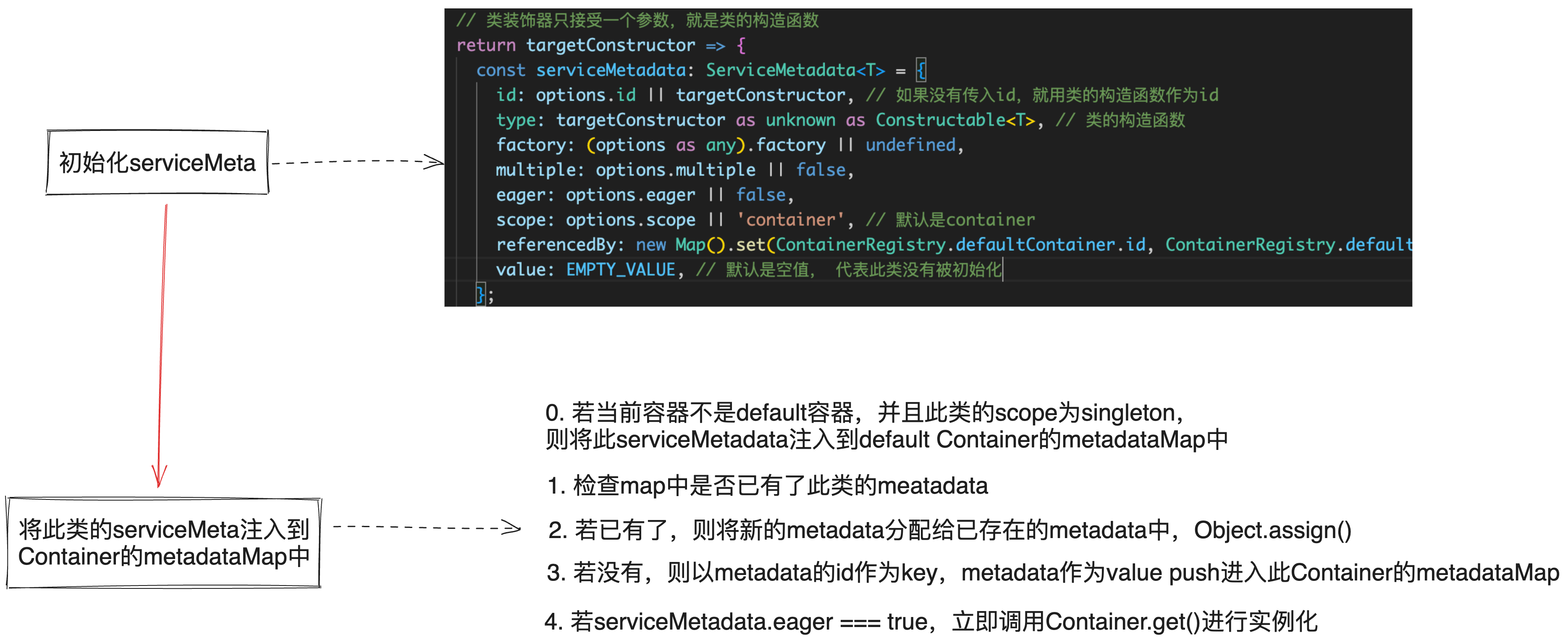
Container.get(id)
Container.get(id)是从容器中获取实例,在这个步骤中完成了类的实例化。
这个框架的核心就是get()方法
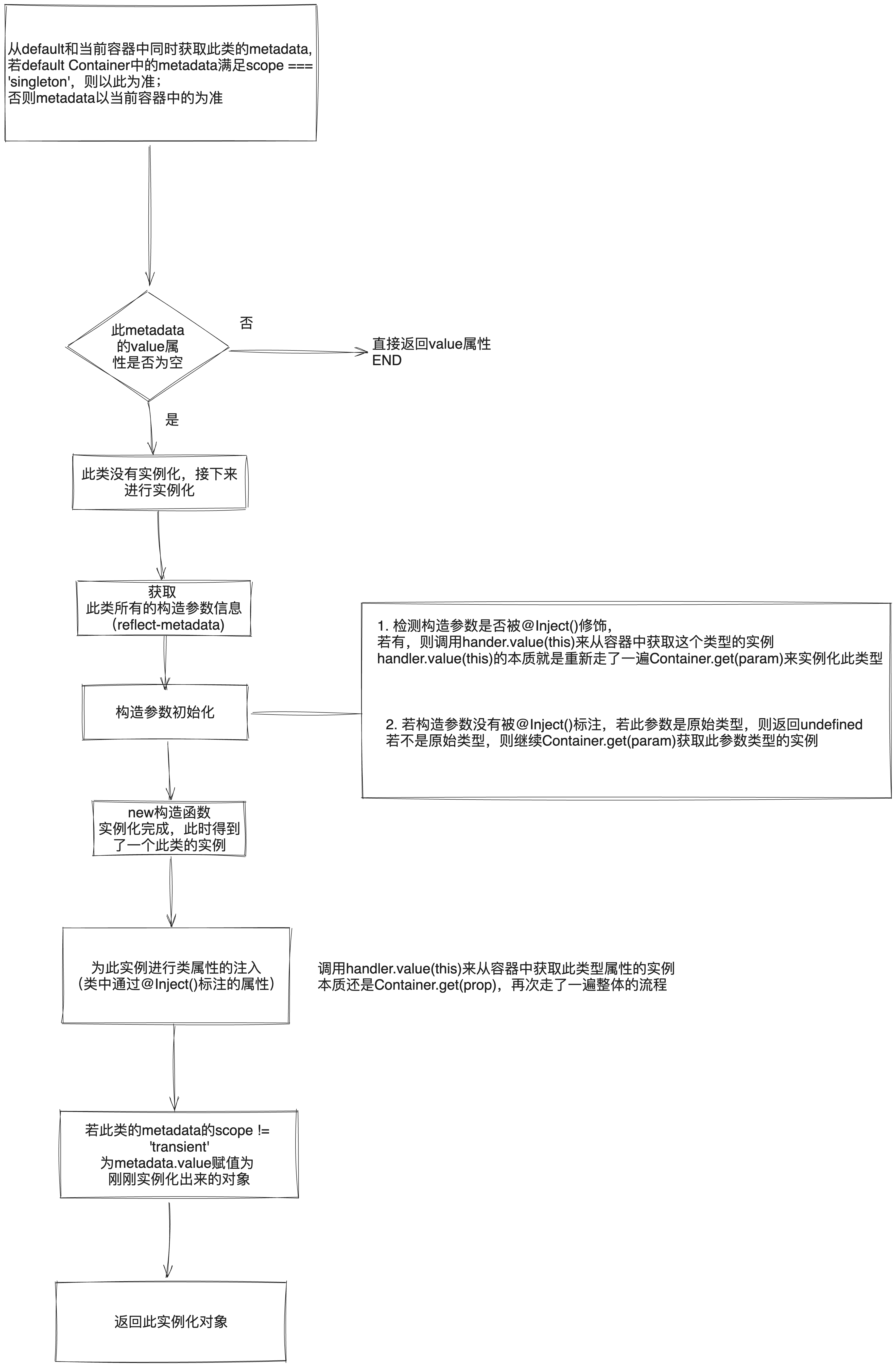
总结
基于Container的依赖注入,无非就是两件事,向Container中push实例和从Container中get实例。
typedi采用了惰性加载的方式,初始只保存类的metadata(类的配置信息),
Container.get()时才会对类进行实例化,而在类实例化的过程中,如果检测都有需要注入的属性,则会继续调用Container.get()来实例化属性,经典的递归形式;后续如果如果要获取某个实例,判断已经实例化了直接返回,就不需要继续实例化了
typedi这个框架设计非常小巧强悍,代码简洁,支持自定义拓展。

